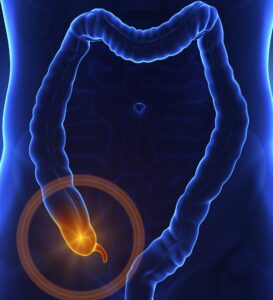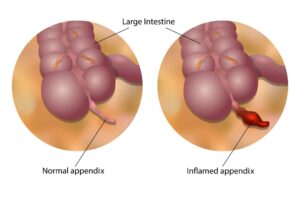



Appendix surgery, commonly referred to as an appendectomy, is the surgical removal of the appendix, a small, tube-shaped pouch attached to the large intestine. The appendix is located in the lower right abdomen, and while its exact function is not entirely clear, it is considered part of the gastrointestinal and immune systems. Appendicitis, the inflammation of the appendix, is the most common reason for an appendectomy. If untreated, appendicitis can lead to severe complications, making timely surgical intervention crucial. Our expert surgical team Dr.Thangapragasam MS, Dr.Shankar MS, DA and Dr.Siva Subramaniyan are very good in clinical diagnosis and also are capable of handling cases with come in delayed presentation https://www.mountsinai.org/health-library/surgery/appendectomy
Types of Appendectomy
There are two main types of appendectomy:
-
- Open Appendectomy: This traditional approach involves a single, larger incision in the lower right abdomen to remove the appendix. It has been the standard method for many years and is still used in certain situations, such as when the appendix has ruptured or there is an extensive infection.
- Laparoscopic Appendectomy: This modern, minimally invasive technique involves several small incisions through which a laparoscope (a small camera) and surgical instruments are inserted. The laparoscope provides a magnified view of the internal organs on a monitor, allowing the surgeon to perform the procedure with high precision.
Benefits of Laparoscopic Appendectomy
Laparoscopic appendectomy has become the preferred method due to its numerous advantages over the open approach. These benefits include:
-
- Reduced Scarring: Laparoscopic surgery requires smaller incisions compared to the larger one needed for an open appendectomy. As a result, the scarring is minimal, which is particularly beneficial for cosmetic reasons and patient satisfaction.
- Less Postoperative Pain: Smaller incisions mean less trauma to the abdominal muscles and tissues, leading to significantly reduced postoperative pain. This can enhance the overall recovery experience for patients.
- Faster Recovery: Patients undergoing laparoscopic appendectomy typically experience a quicker recovery period. They can often resume normal activities and return to work sooner than those who undergo an open appendectomy.
- Shorter Hospital Stay: The minimally invasive nature of laparoscopic surgery usually results in a shorter hospital stay. This reduction not only lowers healthcare costs but also decreases the risk of hospital-acquired infections.
- Lower Risk of Infection: Smaller surgical wounds are associated with a lower risk of infection compared to larger wounds from open surgery. This minimizes the chances of postoperative complications and promotes faster healing.
- Better Visualization: The laparoscopic approach provides a clearer and more magnified view of the abdominal cavity. This allows the surgeon to accurately identify and remove the appendix while minimizing damage to surrounding tissues. This improved visualization is particularly useful in complex cases or when the diagnosis is uncertain. https://www.umms.org/ummc/health-services/gastroenterology-hepatology/general-gi-surgery/appendectomy
Indications for Appendectomy
The primary indication for an appendectomy is acute appendicitis. Symptoms of appendicitis typically include:
-
- Sudden onset of abdominal pain, usually starting around the navel and then shifting to the lower right abdomen.
-
- Nausea and vomiting.
-
- Loss of appetite.
-
- Fever.
-
- Abdominal swelling.
-
- Pain that worsens with movement, coughing, or sneezing.
Prompt surgical intervention is necessary if appendicitis is suspected to prevent complications such as perforation (rupture) of the appendix, which can lead to peritonitis (infection of the abdominal cavity) and abscess formation.
Laparoscopic Appendectomy Procedure
Preparation: The patient is administered general anesthesia. The abdomen is cleaned and prepped for surgery.
Incisions: Several small incisions (typically 3-4) are made in the abdomen. A laparoscope is inserted through one incision to provide a view of the abdominal cavity on a monitor.
Access and Removal: Surgical instruments are inserted through other incisions. The appendix is identified, isolated, and removed. The area is inspected for any signs of infection or complications.
Closure: The incisions are closed with sutures or staples, and sterile dressings are applied.
https://www.sages.org/publications/patient-information/patient-information-for-laparoscopic-appendectomy-from-sages/
Recovery and Postoperative Care
Postoperative Care:
-
- Monitoring: Patients are closely monitored for signs of complications such as infection or bleeding.
- Pain Management: Pain is managed with medications as needed.
- Activity: Early ambulation is encouraged to prevent blood clots and promote healing.
- Diet: A gradual return to a normal diet is recommended, starting with clear liquids and progressing to solid foods as tolerated.
Recovery Tips:
-
- Follow the surgeon’s instructions regarding wound care and activity restrictions.
-
- Avoid heavy lifting and strenuous activities for several weeks.
-
- Stay hydrated and eat a balanced diet to support healing.
-
- Attend all follow-up appointments to ensure proper recovery and address any concerns.
Are Anaesthetist team Dr.Ravi DA & Dr.Pounpandian MD give a very comfortable post op analgesics for the patient having a good recovery.
Conclusion
Laparoscopic appendectomy is a highly effective and minimally invasive procedure for treating appendicitis. Its numerous benefits, including reduced scarring, less pain, faster recovery, shorter hospital stays, and lower risk of infection, make it the preferred method for appendectomy in most cases. Prompt surgical intervention is crucial in cases of suspected appendicitis to prevent serious complications and ensure a swift return to health. As medical technology continues to advance, laparoscopic techniques will likely become even more refined, further improving patient outcomes and solidifying its role in modern surgical practice. These surgeries are done under packages, with no extra cost and also have many insurances under cashless medical treatment.






